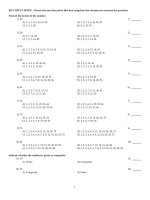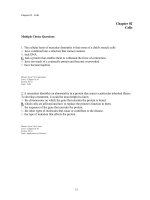Lecture Contemporary strategy analysis: Concepts, techniques, applications (5th edition): Chapter 13 - Robert M. Grant
Bạn đang xem bản rút gọn của tài liệu. Xem và tải ngay bản đầy đủ của tài liệu tại đây (80.74 KB, 7 trang )
<span class='text_page_counter'>(1)</span><div class='page_container' data-page=1>
<b>Vertical Integration and </b>
<b>The Scope of the Firm</b>
<b>Vertical Integration and </b>
<b>The Scope of the Firm</b>
•
<b>Transactions Costs and the Scope of the Firm</b>
<b>--Why does the firm exist?</b>
<b>--The evolution of firms and markets</b>
•
<b>The Costs and Benefits of Vertical Integration</b>
•
<b>Designing Vertical Relationships</b>
•
<b>Recent Trends</b>
</div>
<span class='text_page_counter'>(2)</span><div class='page_container' data-page=2>
<b>From Business Strategy to Corporate </b>
<b>Strategy: The Scope of the Firm</b>
<b>From Business Strategy to Corporate </b>
<b>Strategy: The Scope of the Firm</b>
•
<i><b>Business Strategy </b></i>
<b>is concerned with </b>
<i><b>how</b></i>
<b> a firm </b>
<b>computes within a particular market</b>
•
<i><b>Corporate Strategy </b></i>
<b>is concerned with </b>
<i><b>where</b></i>
<b> a </b>
<b>firm competes, i.e. the </b>
<i><b>scope</b></i>
<b> of its activities</b>
•
<b>The dimensions of scope are</b>
–
<b>geographical scope</b>
–
<b>vertical scope</b>
</div>
<span class='text_page_counter'>(3)</span><div class='page_container' data-page=3>
<b>P<sub>1</sub></b> <b>P<sub>2</sub></b> <b>P<sub>3</sub></b> <b>C<sub>1</sub></b> <b>C<sub>2</sub></b> <b>C<sub>3</sub></b>
<i><b>Vertical</b></i>
<i><b>Product </b></i>
<i><b>Geographical</b></i>
<i><b>Scope</b></i>
<i><b>Scope</b></i>
<i><b>Scope</b></i>
<b>V<sub>1</sub></b>
<b>V<sub>2</sub></b>
<b>V<sub>3</sub></b> <b>P1</b> <b>P2</b> <b>P3</b> <b>C1</b> <b>C2</b> <b>C3</b>
<b>V<sub>1</sub></b>
<b>V<sub>2</sub></b>
<b>V<sub>3</sub></b>
<i><b>[A] Single </b></i>
<i><b>Integrated</b></i>
<i><b>Firm</b></i>
<i><b>[B] Several</b></i>
<i><b>Specialized </b></i>
<i><b>Firms linked</b></i>
<i><b>by Markets</b></i>
<b>In situation [A] the business units are integrated within a single firm.</b>
<b>In situation [B] the business units are independent firms linked by markets.</b>
<b>Are the administrative costs of the integrated firm less than the transaction</b>
<b>costs of markets?</b>
<b>Transactions Costs and the</b>
<b> Scope of the Firm</b>
</div>
<span class='text_page_counter'>(4)</span><div class='page_container' data-page=4>
<b>Transactions Costs and The </b>
<b>Existence of the Firm</b>
<b>Transactions Costs and The </b>
<b>Existence of the Firm</b>
•
<b>Transaction cost theory explains not just the </b>
<i><b>boundaries</b></i>
<i><b> of firms</b></i>
<b>, also the </b>
<i><b>existence of firms</b></i>
<b>.</b>
•
<b>In 18th century English woollen industry, no firms –</b>
<b> independent spinners and weavers linked by merchants.</b>
•
<b>Residential remodeling industry -- mainly independent </b>
<b> employed builders, plumbers, electricians, painters.</b>
•
<b>Key issue -- transaction costs of the market vs. </b>
<b> administrative costs of firms.</b>
•
<b>Where transaction costs high—firm is more efficient means</b>
<b> of organization</b>
</div>
<span class='text_page_counter'>(5)</span><div class='page_container' data-page=5>
<b>Changes in Aggregate </b>
<b>Concentration Over Time</b>
<b>Concentration Over Time</b>
•<b> For most of the 19th<sub> & 20</sub>th<sub> centuries industrial firms have expanded their </sub></b>
<b>vertical, geographical and product scope. Why?</b>
•<b> From the late 1970s to the mid-1990s, this trend reversed. Large</b>
<b> companies began downsizing, outsourcing, and refocusing. Why? </b>
•<b> Why the recent renewal of concentration in the industrial sector?</b>
</div>
<span class='text_page_counter'>(6)</span><div class='page_container' data-page=6>
<b>Determinants of Changes in Corporate Scope</b>
<b>Determinants of Changes in Corporate Scope</b>
<b>1800 – 1980 </b>
<b>Expanding scale and scope of industrial corporations due to</b><b>declining administrative costs of firms:</b>
•<b> Advances in transportation, information and communication</b>
<b> technologies</b>
•<b> Advances in management—accounting systems, decision sciences, </b>
<b> financial techniques, organizational innovations, scientific management</b>
<b>1980 – 1995</b>
<b> Shrinking size and scope of biggest industrial corporations. </b><b>Increasingly </b> <b>Increased no. of managerial </b> <b>Admin. costs of</b>
<b>turbulent </b> <b>decisions. Need for fast</b> <b>firms rise relative </b>
<b>external </b> <b>responses to external</b> <b> to transaction </b>
<b>environment </b> <b>change</b> <b>costs of markets</b>
<b>1995 – 2004</b>
<b> Rapid increase in global concentration (autos, aluminium, </b><b>oil, beer, banking, cement). </b>
<b>Key drivers: quest for market power and scale economies.</b>
</div>
<span class='text_page_counter'>(7)</span><div class='page_container' data-page=7>
<b>The Costs and Benefits of Vertical </b>
<b>Integration: BENEFITS</b>
<b>The Costs and Benefits of Vertical </b>
<b>Integration: BENEFITS</b>
•
<b>Technical economies from integrating processes e.g. iron </b>
<b>and steel production</b>
<b>—but doesn’t necessarily require common ownership</b>
•
<b>Superior coordination </b>
•
<b>Avoids transactions costs of market contracts in situations </b>
<b>where there are:</b>
<b>-- small numbers of firms</b>
<b>-- transaction-specific investments</b>
</div>
<!--links-->









